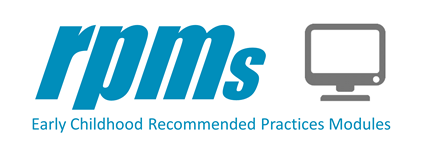Module 3 Learning Guides
These guides are used by and facilitated by instructors with learners. They are designed to extend the learning in the self-paced modules.
General Guides
- For Instructors: RPM Learning and Improvement Framework
- Embedding the Modules into Existing Coursework and Practicum
- Introduction to the Crosswalks
- Environment Crosswalk
Learning Guides
Guide Name and Description/Objectives |
Related Lesson/Module Section |
| PLAN SECTION | |
|
Learning Guide 3.1: Setting the Stage With this guide, learners will:
|
Setting the Stage (2:10 run time) You will meet Erica and her son Tyler, a 2-year-old child with visual impairment. Tyler’s visual specialist, Judy wants to help Erica work on environmental accommodations and modifications to facilitate Tyler’s independence and participation in daily routines. |
|
Learning Guide 3.2: Ask The Expert With this guide, learners will:
|
Lesson 1: Ask the Expert (3:39 run time) Environment is defined and the best available research on environmental practices is summarized by Dr. Lori Meyer and Tricia Catalino |
|
Learning Guide 3.3: Gathering Information With this guide, learners will:
|
Lesson 2: Gathering the Information (15:30 run time) Components of the child’s environment and how changes to the environment can serve as an intervention strategy to promote access and participation of all children, especially children with disabilities, are explained with examples and activities. |
|
Learning Guide 3.4: Take Action With this guide, learners will:
|
Lesson 3: Take Action (5:50 run time) Strategies on how to observe the child’s level of participation and how to modify or adapt the environment, and how to use assistive technology to support child learning, are explained with examples and activities. |
|
Learning Guide 3.5: Voices from the Field With this guide, learners will:
|
Lesson 4: Voices from the Field Practitioners and family leaders share their expertise and perspectives of using environmental practices with young children. |
| DO and STUDY SECTIONS | |
|
Learning Guide 3.6: Scenario-Based Activity This guide contains a set of five simulations/scenarios that can be used in place of, or in addition to, the online simulation. With this guide:
Learning Guide 3.7: Reframing Activity Guide With this guide:
|
|
| ACT SECTION | |
|
Learning Guide 3.8: Performance Feedback Guide This guide can be used with learners who have designed or participated in designing environments for young children with disabilities in either their own classroom/setting/program or in field-experiences associated with university coursework. Learning Guide 3.9: Practice Profile Environmental practices refer to aspects of the space, materials (toys, books, etc.), equipment, routines, and activities that practitioners and families can intentionally alter to support each child’s learning across developmental domains. Learning Guide 3.10: Setting the Stage- Wrap-Up With this guide, learners will:
|
Module 3 Act Section |
Got questions? Looking for SCORM-ready lessons to embed in your LMS? Contact rpm@unc.edu
